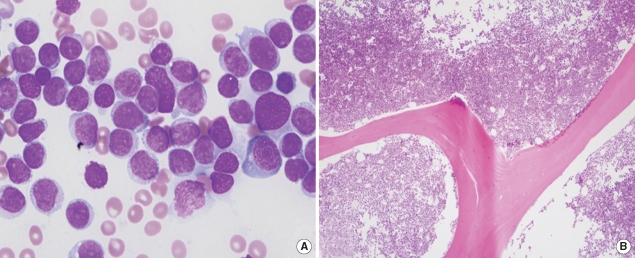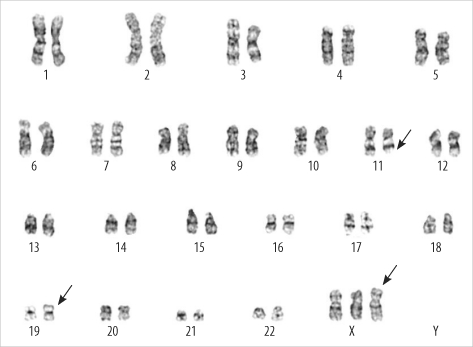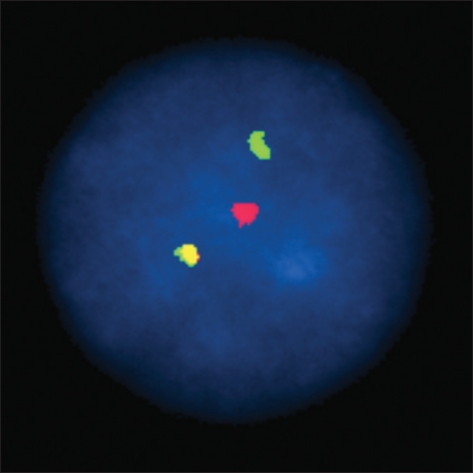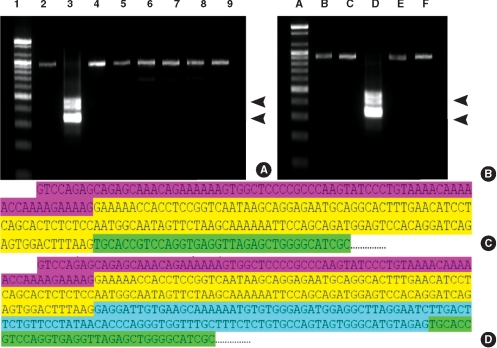Korean J Lab Med.
2011 Jan;31(1):13-17. 10.3343/kjlm.2011.31.1.13.
A Case of Therapy-related Acute Lymphoblastic Leukemia with t(11;19)(q23;p13.3) and MLL/MLLT1 Gene Rearrangement
- Affiliations
-
- 1Department of Laboratory Medicine, Korea University College of Medicine, Seoul, Korea. labmd@korea.ac.kr
- 2Department of Hemato-Oncology, Korea University College of Medicine, Seoul, Korea.
- KMID: 1096654
- DOI: http://doi.org/10.3343/kjlm.2011.31.1.13
Abstract
- Therapy-related ALL (t-ALL) is a rare secondary leukemia that develops after chemotherapy and/or radiotherapy for primary malignancies. Chromosomal 11q23 abnormalities are the most common karyotypic alterations in t-ALL. The t(11;19)(q23;p13) aberration is extremely rare and has not been confirmed at the molecular genetic level. Here, we report a case of t-ALL with t(11;19)(q23;p13.3) and MLL-MLLT1 (alias ENL) gene rearrangement confirmed by cytogenetic analysis, multiplex reverse transcription-PCR (multiplex RT-PCR), and DNA sequencing in a patient who had undergone treatment for breast cancer. A 40-yr-old woman developed acute leukemia 15 months after undergoing 6 cycles of adjuvant chemotherapy (doxorubicin 60 mg/m2 and cyclophosphamide 600 mg/m2), radiation therapy (dose, 5,900 cGy), and anticancer endocrine therapy with tamoxifen. The complete blood cell counts and bone marrow examination showed increased blasts and the blasts showed B lineage immunophenotype (positive for CD19, CD34, and cytoplasmic CD79a). Cytogenetic analysis revealed the karyotype 47,XX,+X,t(11;19)(q23;p13.3)[4]/46,XX[16]. FISH analyses, multiplex RT-PCR, and DNA sequencing confirmed the MLL-MLLT1 gene rearrangement. The patient underwent induction chemotherapy with fractionated cyclophosphamide, vincristine, doxorubicin, and dexamethasone (Hyper-CVAD) and achieved complete remission. Subsequently, she underwent consolidation chemotherapy, but died of brain ischemia in the pons and the region of the middle cerebral artery. To our knowledge, this is the first case report of t-ALL with t(11;19)(q23;p13.3) and the MLL-MLLT1 gene rearrangement.
MeSH Terms
-
Adult
Antineoplastic Agents/therapeutic use
Base Sequence
Breast Neoplasms/drug therapy/radiotherapy
*Chromosomes, Human, Pair 11
*Chromosomes, Human, Pair 19
Combined Modality Therapy
Cyclophosphamide/therapeutic use
Doxorubicin/therapeutic use
Female
Gene Rearrangement
Humans
Immunophenotyping
Karyotyping
Molecular Sequence Data
Myeloid-Lymphoid Leukemia Protein/*genetics
Neoplasm Proteins/*genetics
Nuclear Proteins/*genetics
Precursor Cell Lymphoblastic Leukemia-Lymphoma/*diagnosis/genetics
Sequence Analysis, DNA
Tamoxifen/therapeutic use
Transcription Factors/*genetics
*Translocation, Genetic
Figure
Reference
-
1. Zhang Y, Poetsch M, Weber-Matthiesen K, Rohde K, Winkemann M, Haferlach T, et al. Secondary acute leukaemias with 11q23 rearrangement: clinical, cytogenetic, FISH and FICTION studies. Br J Haematol. 1996; 92:673–680. PMID: 8616034.
Article2. Ishizawa S, Slovak ML, Popplewell L, Bedell V, Wrede JE, Carter NH, et al. High frequency of pro-B acute lymphoblastic leukemia in adults with secondary leukemia with 11q23 abnormalities. Leukemia. 2003; 17:1091–1095. PMID: 12764373.
Article3. Pagano L, Pulsoni A, Mele L, Leone G. Clinical and epidemiological features of acute lymphoblastic leukemia following a previous malignancy. Leuk Lymphoma. 2000; 39:465–475. PMID: 11342330.
Article4. Secker-Walker LM, Moorman AV, Bain BJ, Mehta AB. Secondary acute leukemia and myelodysplastic syndrome with 11q23 abnormalities. EU Concerted Action 11q23 Workshop. Leukemia. 1998; 12:840–844. PMID: 9593290.5. Chen W, Wang E, Lu Y, Gaal KK, Huang Q. Therapy-related acute lymphoblastic leukemia without 11q23 abnormality: report of six cases and a literature review. Am J Clin Pathol. 2010; 133:75–82. PMID: 20023261.6. Hrusák O, Porwit-MacDonald A. Antigen expression patterns reflecting genotype of acute leukemias. Leukemia. 2002; 16:1233–1258. PMID: 12094248.
Article7. Andersen MK, Christiansen DH, Jensen BA, Ernst P, Hauge G, Pedersen-Bjergaard J. Therapy-related acute lymphoblastic leukaemia with MLL rearrangements following DNA topoisomerase II inhibitors, an increasing problem: report on two new cases and review of the literature since 1992. Br J Haematol. 2001; 114:539–543. PMID: 11552977.
Article8. Cho J, Hur M, Moon HW, Yun YM, Lee CH, Lee HG. A case of therapy-related ALL with MLL gene rearrangement following treatment of breast cancer. Korean J Lab Med. 2010; 30:255–259. PMID: 20603585.
Article9. Thandla S, Alashari M, Green DM, Aplan PD. Therapy-related T cell lymphoblastic lymphoma with t(11;19)(q23;p13) and MLL gene rearrangement. Leukemia. 1999; 13:2116–2118. PMID: 10602439.
Article10. Kobayashi Y, Yang J, Shindo E, Tojo A, Tani K, Ozawa K, et al. HRX gene rearrangement in acute lymphoblastic leukemia after adjuvant chemotherapy of breast cancer. Blood. 1993; 82:3220–3221. PMID: 8219210.11. Burmeister T, Meyer C, Schwartz S, Hofmann J, Molkentin M, Kowarz E, et al. The MLL recombinome of adult CD10-negative B-cell precursor acute lymphoblastic leukemia: results from the GMALL study group. Blood. 2009; 113:4011–4015. PMID: 19144982.
Article12. Huret JL, Brizard A, Slater R, Charrin C, Bertheas MF, Guilhot F, et al. Cytogenetic heterogeneity in t(11;19) acute leukemia: clinical, hematological and cytogenetic analyses of 48 patients--updated published cases and 16 new observations. Leukemia. 1993; 7:152–160. PMID: 8426468.13. Mitani K, Sato Y, Kobayashi Y, Shibasaki Y, Kasuga M, Inaba T, et al. Heterogeneity in the breakpoints of chromosome 19 among acute leukemic patients with the t(11;19)(q23;p13) translocation. Am J Hematol. 1989; 31:253–257. PMID: 2741924.14. Hudson MM, Raimondi SC, Behm FG, Pui CH. Childhood acute leukemia with t(11;19) (q23;p13). Leukemia. 1991; 5:1064–1068. PMID: 1774955.15. Moorman AV, Hagemeijer A, Charrin C, Rieder H, Secker-Walker LM. European 11q23 Workshop participants. The translocations, t(11;19)(q23;p13.1) and t(11;19)(q23;p13.3): a cytogenetic and clinical profile of 53 patients. Leukemia. 1998; 12:805–810. PMID: 9593285.
Article16. Fu JF, Liang DC, Shih LY. Analysis of acute leukemias with MLL/ENL fusion transcripts: identification of two novel breakpoints in ENL. Am J Clin Pathol. 2007; 127:24–30. PMID: 17145626.17. Rubnitz JE, Camitta BM, Mahmoud H, Raimondi SC, Carroll AJ, Borowitz MJ, et al. Childhood acute lymphoblastic leukemia with the MLL-ENL fusion and t(11;19)(q23;p13.3) translocation. J Clin Oncol. 1999; 17:191–196. PMID: 10458233.
Article18. Pui CH, Behm FG, Downing JR, Hancock ML, Shurtleff SA, Ribeiro RC, et al. 11q23/MLL rearrangement confers a poor prognosis in infants with acute lymphoblastic leukemia. J Clin Oncol. 1994; 12:909–915. PMID: 8164041.
Article19. Rubnitz JE, Link MP, Shuster JJ, Carroll AJ, Hakami N, Frankel LS, et al. Frequency and prognostic significance of HRX rearrangements in infant acute lymphoblastic leukemia: a Pediatric Oncology Group study. Blood. 1994; 84:570–573. PMID: 8025282.
Article20. Schoch C, Schnittger S, Klaus M, Kern W, Hiddemann W, Haferlach T. AML with 11q23/MLL abnormalities as defined by the WHO classification: incidence, partner chromosomes, FAB subtype, age distribution, and prognostic impact in an unselected series of 1897 cytogenetically analyzed AML cases. Blood. 2003; 102:2395–2402. PMID: 12805060.
Article
- Full Text Links
- Actions
-
Cited
- CITED
-
- Close
- Share
- Similar articles
-
- A Case of Congenital Acute Lymphoblastic Leukemia
- Acute Monocytic Leukemia with t(11;17)(q23;q21) Involving a Rearrangement of Mixed Lineage Leukemia Gene
- A Case of Therapy-related ALL with MLL Gene Rearrangement Following Treatment of Breast Cancer
- Rapid Detection of Prognostically Significant Fusion Transcripts in Acute Leukemia Using Simplified Multiplex Reverse Transcription Polymerase Chain Reaction
- Acute Monoblastic Leukemia with t(11;17)(q23;q21): Fusion of the KMT2A(MLL) and MLLT6(AF17) Genes





